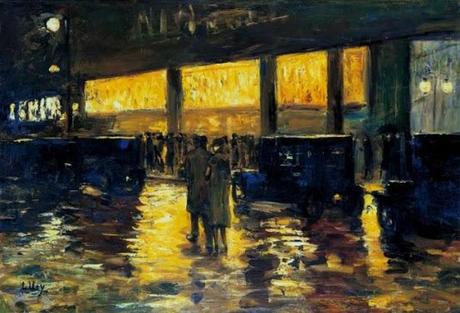
Before The Cafe, Lesser Ury, 1920s
Guest blogger Karin (aka/Whistlingypsy) of Distant Voices and Flickering Shadows is a freelance technical writer living in the Austin area. She has contributed to Reel Life in the past, treating readers to lyrical prose as well as a unique exploration of her subject in every case - from her two-part series on legendary art director Van Nest Polglase in 2010, to her entry on composer Bernard Herrmann for my Vertigo blog event early in 2012, to her contribution, "The Feminine Mystique of Mad Men," for my Mad Men blog event later that year. Karin's current fascination is Weimar-era Berlin's art, cabaret, cinema and music scene...~ The Lady Eve
Classic films offer the viewer an opportunity to glimpse, however briefly and dimly, the world in which the audience and the performer lived. Classic films can also provide an imperfect record of the psychological and sociological issues of concern to the public. For many of us, German cinema during the Weimar era remains frustratingly elusive, while art and auteur
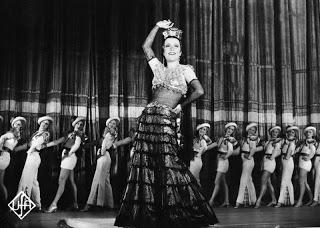
Renate Müller performs "Castle in Spain"
in Viktor und Viktoria
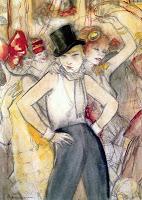
She Represents
Jeanne Mammen (1927)
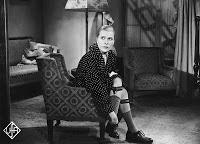
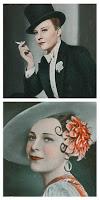

Georges et Georgette (1934)
During the early sound era, the practice of filming additional versions for foreign markets was common in both Europe and Hollywood. The same year Viktor und Victoria was filmed in German; Georges et Georgette (1934) was filmed for French language audiences. Anton Walbrook reprised his role as Robert, Meg Lemonnier took over the role of Susanne and Julien Carette (La Grande Illusion) appeared as Georges. In 1935, Jessie Matthews, the dancing divinity, princess personality and the girl Bette Davis called ‘England’s greatest star’ appeared in a British Gaumont-Gainsborough remake.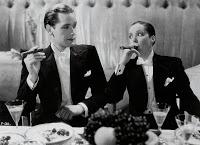
First A Girl (1935)
The plot of First A Girl (1935) is expanded to include a job in a dress shop for Elizabeth (Matthews), which allows for additional song and dance numbers. Viktor und Viktoria (1957) is an Agfacolor quality film and strays the farthest from the original. Erika (Susanne in the original) invents a brother as part of her "cover story", and when Erika can no longer maintain the charade, she tells Viktor she has “killed” her brother, Erik. Through a comedy of errors, Erika is arrested for the “murder”, and her beloved Jean (Robert in the original) confesses to complicity in the murder. A comparison of the double-exposure travel montage from Viktor und Viktoria to the same from First A Girl reveals the latter's faithful adaptation (the quality of the first is a bit squiffy, the dialog is in German, but Susanne sings "Castle in Spain" in English).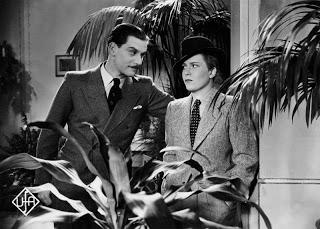
Robert and Susanne get "uncomfortable"
Schünzle’s film is certainly available for gay and gender film scholarship, but in its charmingly prim manner, the premise extends few invitations. The material for Schünzel’s Viktor und Viktoria becomes a sophisticated adult comedy and adds levels of gender ambiguity, when the traditional plot of a woman dressing as a man evolves to a woman passing for a man. The film also expands the notion of pre-code films and takes the screwball comedy to levels Lubitsch and Mamoulian would not have been permitted to explore, in which feelings are present but denied or thwarted. However, contemporary audiences and non-German speaking viewers are at a disadvantage in appreciating the film’s allusions and nuanced jokes. The most skillful effort of translation can take the viewer only so far in understanding an element of humor uniquely rooted in Berlin joke-telling. In his book Berlin Cabaret, Peter Jelavich recounts an experience of a visitor to the city, “No gestures, no wry faces, no smirks: the Berliner is dry and cold-blooded when he jokes. He displays an intentionally deadpan countenance, which stands in such contrast to his words that it never fails to provoke laughter” (many cabaret performers stood absolutely still while performing). This aspect of Berlin and cabaret style humor is reflected in Robert and Susanne’s inexplicably tense manner of flirtation, which initially seems counter-intuitive to notions of joke delivery.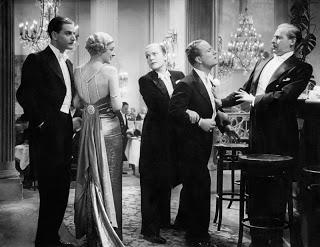
Viktor und Viktoria's ensemble cast
Robert’s bemused fascination quickly turns to gleeful torment after discovering Susanne’s secret and realizing the many ways he can use this against her. Although a visit to the barber and a visit to a seedy cellar cabaret play-out ironically, Susanne remains a sweet, if baffled, young woman in over her head, showing no hint of the transparent sexuality Dietrich displays in her Lola-Lola or Amy Jolly characters. This is hardly surprising given the political climate in Berlin at the time. Work on the film began, and the film's premier occurred, within month's of the Nazi accession to power. In October of 1932, Berlin’s chief of police ordered a ban on same-sex couples dancing in public. In January of 1933, the process of gleichschaltung (“the forcing into conformity”) brought artistic organizations under state control while eliminating objectionable artists from the field. The hugely popular Eldorado cabaret became the headquarters of the Sturmabteilung (SA), and in February of 1933, Hermann Goering ordered closure of similar establishments and instituted the arrest and imprisonment of gays and transvestites.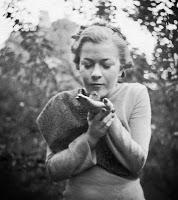
Renate Müller
In the absence of a definitive biography, Renate Müller’s life and early death have acquired legendary proportions. However, a search of available publications makes it possible to sketch a less sensational portrait of the actress’s last days. Renate Müller's skills as a singer and her knowledge of foreign languages made her the ideal actress for musical comedies. The actress made twenty-five films between 1929 and 1937, and her role in Reinhold Schünzel’s Peter der Matrose (1929) was the first of seven comedies in which she appeared for the director. Her sister, Gabriele Müller, described Renate’s screen appeal and why she captivated Weimar era audiences, “A new type of character was born in German film: after the ‘vamp’ and the ‘cute girlie’, there appeared a girl with heart who wasn’t a sweetheart, who was smart but not a bluestocking, charming yet not coy – a down-to-earth and bracingly natural girl.” Her trip to England in the summer of 1931 to film Sunshine Susie, as part of a British Gaumont-Gainsborough-Ufa film exchange, was reported widely in the cinema related press, and her personal appearances drew large crowds of fans.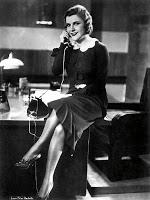
Renate Müller
in Sunshine Susie (1931)
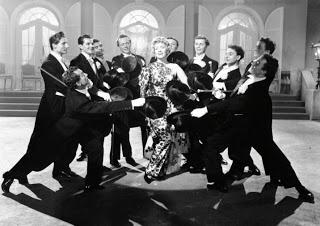
A musical number from Liebling Der Götter
Phil M. Daly reported on May 20, 1947 in his column, Along The Rialto (The Film Daily), director Henry Wilcox and his wife, actress Anna Neagle, would produce a film “based on the life and exploits of Renate Müller”. The reporter proceeded to refer to the actress as a “Nazi spy, film actress and musical comedy star” and the proposed film as a “spy thriller”. The actress's biography would eventually receive the cinematic treatment, over protests of surviving family members, in Liebling Der Götter/Darling of The Gods (1957). Tim Bergfelder in International Adventures: German Popular Cinema and European Co-Production describes the film's grim opening, “Even audiences previously unfamiliar with Müller’s fate would have known not to expect a happy ending after an introductory, and rather didactic, caption at the beginning of the film informed them that the narrative would 'portray the life and death of an artist in unfree times'. Contemporary viewers hoping to find a dramatic re-creation of the actress’s life will undoubtedly be disappointed (a bit a trivia, Peter Van Eyck, who plays Renate’s love interest in the film, is said to have been romantically involved with Jean Ross).I would like to thank Lady Eve for her gracious invitation to contribute to her always elegant blog. I would also like to acknowledge the invaluable help provided by DocTom (Thomas) in understanding certain nuances of the German language.
Reference Material: Berlin Cabaret, Peter Jelavich; Film and the German Left in the Weimar Republic: from Caligari to Kuhle Wampe, Bruce Murray; International Adventures: German Popular Cinema and European Co-Production, Tim Bergfelder; The Film Daily, December, 1930, March 1932, May 1947; Weimar Cinema And After: Germany’s Historical Imaginary, Thomas Elsaessar; World Film News and Television Progress: People Of The Studios, May 1937.
Click here for all of Karin's contributions to Reel Life.

